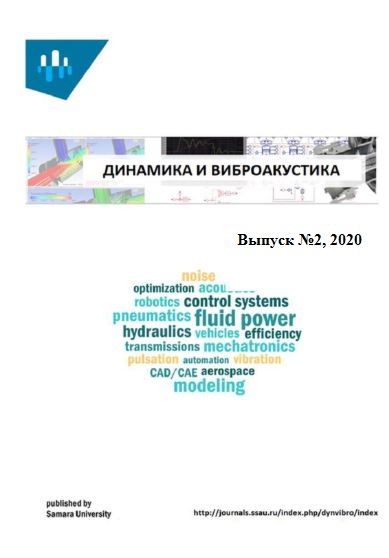Том 6, № 2 (2020): 07.11.2020
- Год: 2020
- Дата публикации: 07.11.2020
- Статей: 5
- URL: https://dynvibro.ru/dynvibro/issue/view/435
-
Описание:
опубликован 07.11.2020 г.
Весь выпуск
Статьи
ПЕРСПЕКТИВЫ ИСПОЛЬЗОВАНИЯ РАЗЛИЧНЫХ КОНСТРУКЦИЙ КЛАПАННЫХ УПЛОТНЕНИЙ ДЛЯ АГРЕГАТОВ, РАБОТАЮЩИХ ПРИ СВЕРХНИЗКИХ ТЕМПЕРАТУРАХ И ДИНАМИЧЕСКИХ НАГРУЗКАХ
Аннотация
Потребность использования водорода, как полноценную замену керосина, возрастает с каждым днем. Еще с прошлого века ведутся, во всем мире исследования по разработки топливной системы, в которой используется водород. Множество технических проблем возникает при использованием данного вещества, как сопоставление авиационному керосину. Одной из важных проблем, является разработка конструкции уплотнения, для клапанов, которая способна за счет своей конструкции и материала из которого сделано КУ, обеспечить максимальный ресурс работы, а также уменьшить усилие привода для герметизации.
 6-11
6-11


ГЕРМЕТИЗАЦИЯ КЛАПАННЫХ УПЛОТНЕНИЙ ДЛЯ КРИОГЕННЫХ СРЕД
Аннотация
В статье представлена методика расчета герметичности стыка клапанных пар различного типа, предназначенных для эксплуатации в экстремальных условиях использования криогенных сред. При воздействии криогенных температур (ниже -120⁰С) происходит существенное изменение механических свойств контактирующих в клапанной паре материалов (повышается σвр, предел текучести и другие механические характеристики материалов). Такое изменение механических свойств требует существенного увеличения контактирующего усилия для герметизации. В статье была определена проводимость стыка и величина натеканий рабочей среды для различных видов поверхностей контакта клапанных пар.
 12-19
12-19


О ВЫБОРЕ ПАРАМЕТРОВ ГАСИТЕЛЕЙ КОЛЕБАНИЙ ДЛЯ ГИДРАВЛИЧЕСКИХ ЦЕПЕЙ СИСТЕМ УПРАВЛЕНИЯ
Аннотация
В статье рассматривается проблема выбора параметров гасителей колебаний для гидравлических цепей систем управления с учётом обеспечения динамической точности системы после их установки. Вводится понятие коэффициента коррекции, представляющего собой отношение изображений по Лапласу соответствующих параметров рабочей среды в гидравлической цепи до и после установки гасителя. Получена зависимость, связывающая относительное отклонение регулируемого параметра системы с коэффициентом коррекции. Сформулировано условие для проверки эффективности действия гасителя с учётом сохранения требуемого качества регулирования в системе.
 20-25
20-25


ОБЕСПЕЧЕНИЕ УСТОЙЧИВОСТИ ГИДРОМЕХАНИЧЕСКИХ СИСТЕМ УПРАВЛЕНИЯ С КЛАПАНАМИ ПОСТОЯННОГО ДАВЛЕНИЯ
Аннотация
В данной статье были определены теоретические зависимости для построения границ устойчивости системы. Проведён анализ влияния характеристик присоединённых цепей на устойчивость клапана постоянного давления. Для подтверждения установленных теоретических зависимостей были проведены экспериментальные исследованиями клапана с соответствующими граничными условиями. В результате получены осциллограммы испытаний клапана при различных присоединённых магистралях.
 26-33
26-33


СТЕНДОВЫЙ КОМПЛЕКС СИНХРОННОГО КОНТРОЛЯ ВИБРОШУМОВЫХ И ФУНКЦИОНАЛЬНЫХ ХАРАКТЕРИСТИК ЭЛЕКТРОГИДРАВЛИЧЕСКОЙ АППАРАТУРЫ
Аннотация
В работе рассмотрены результаты создания и применения автоматизированной системы синхронного контроля виброшумовых и функциональных характеристик электрогидравлической аппаратуры на специализированном гидравлическом стенде.
С ростом скорости протекания процессов в электрогидравлической аппаратуре, количества параметров оценки и требований, предъявляемых к перспективным образцам, возрастает потребность и актуальность во внедрении на специализированных испытательных стендах автоматизированных систем, способных осуществлять запись широкого перечня характеристик. Процесс контроля таких характеристик осложняется необходимостью проведения испытаний электрогидравлической аппаратуры, как на стационарных, так и нестационарных, быстропротекающих режимах её работы. При этом измерение параметров должно осуществляться синхронно и достоверно. Для обеспечения этих условий для создания автоматизированной системы были сформулированы ряд требований, как к оборудованию, так и к программному обеспечению, исходя из критериев функциональности, мобильности, гибкости, модернизируемости и обслуживаемости оборудования.
Помимо аппаратной части было создано специализированное программное обеспечение. Оно включает в себя унифицированную оболочку анализа и регистрации данных, а также SCADA-проекты, представляющие из себя результат объектно-ориентированного программирования.
Использование автоматизированной системы измерения, интегрированной в состав стендового комплекса, позволило осуществить:
- синхронное автоматизированное регистрирование различных параметров, характеризующих быстротекущие процессы (давление, расход, перемещение, температура, вибрация);
- взаимную передачу данных с автоматизированной системы измерений на специализированный управляющий комплекс.
Расширившиеся измерительные возможности позволили более всесторонне оценивать виброшумовые и функциональные характеристики работы электрогидравлической аппаратуры, определять их взаимосвязь, осуществлять настройку и доработку конструктивных решений такой аппаратуры, достигая требуемых параметров её работы.
 34-41
34-41











